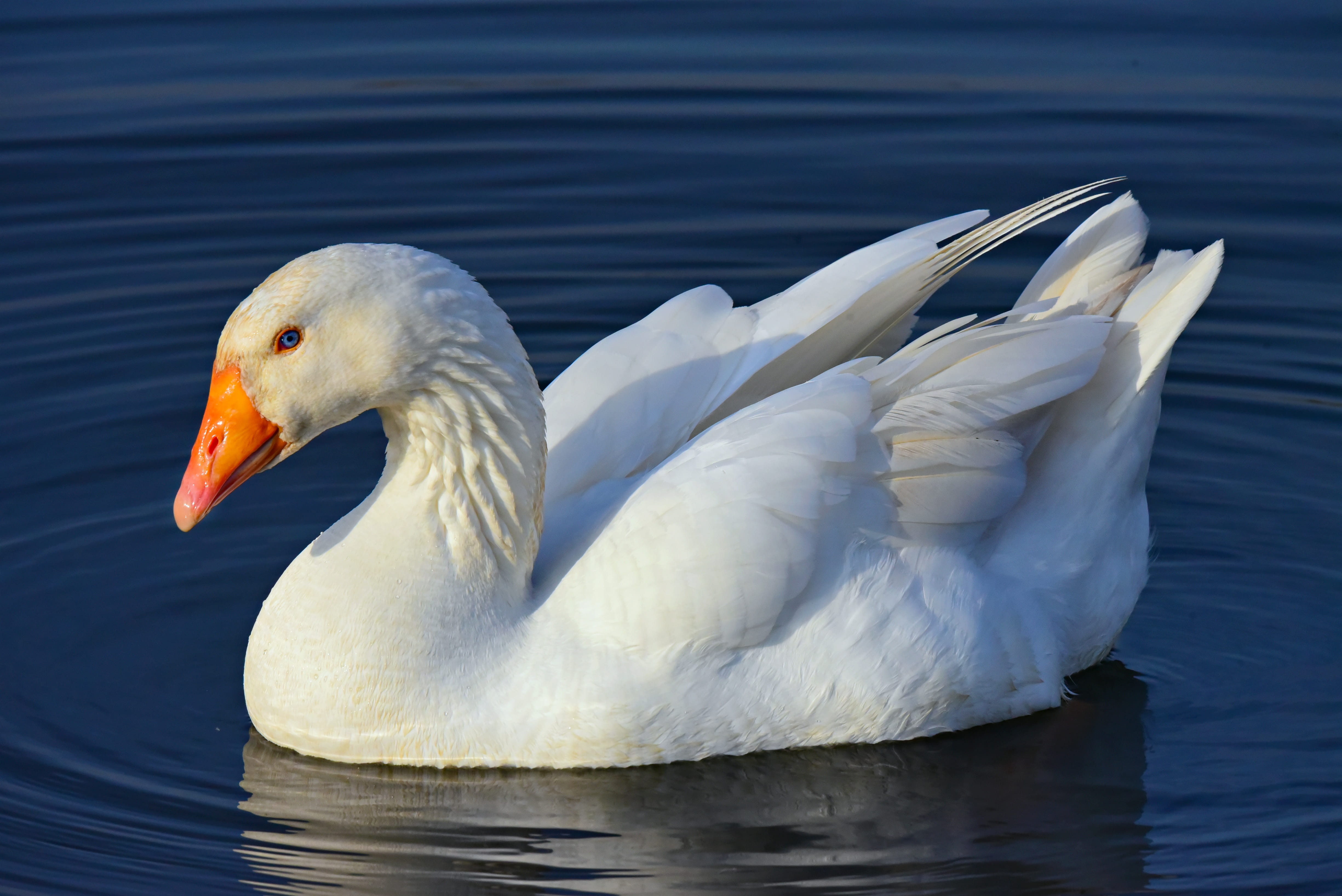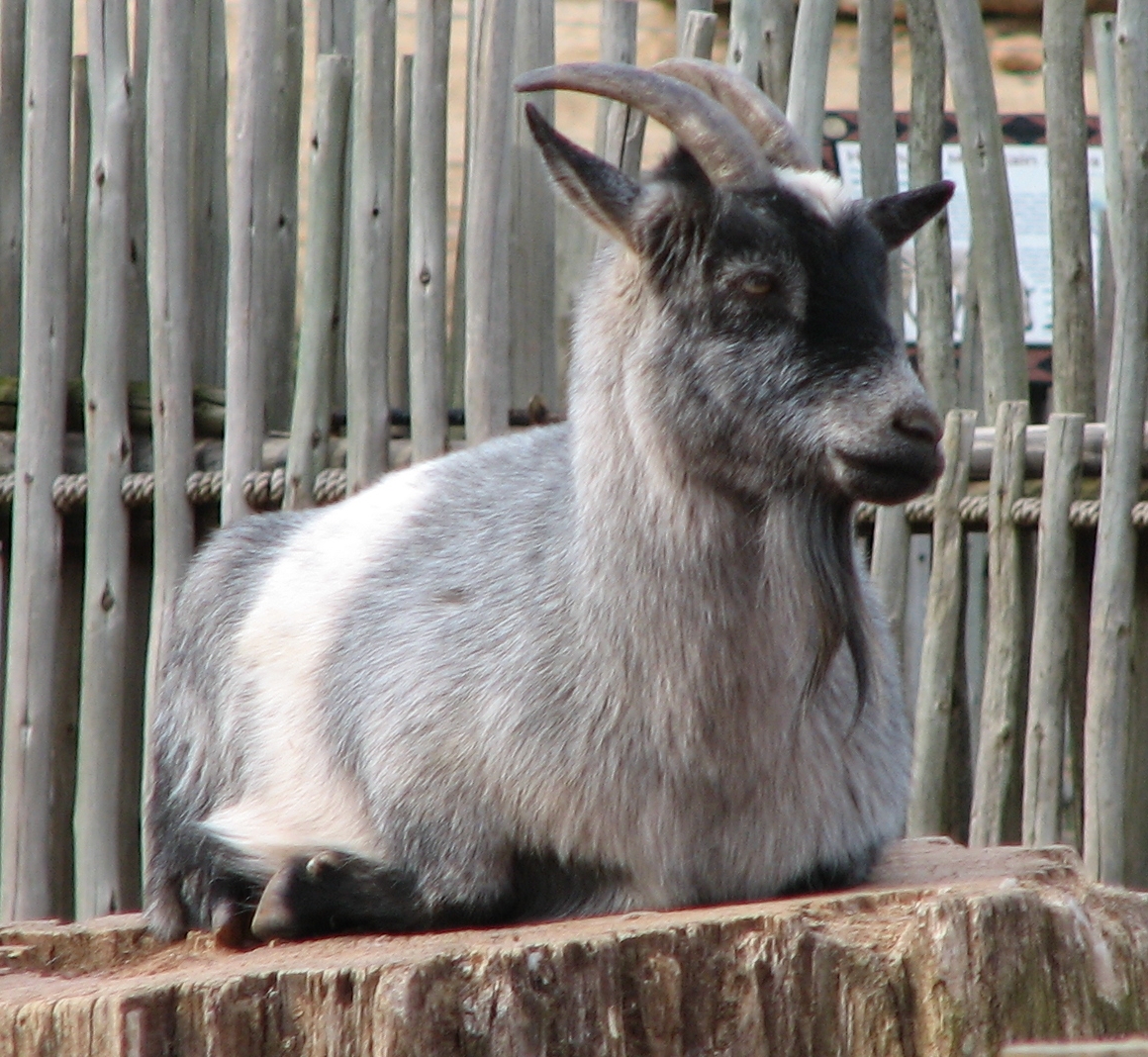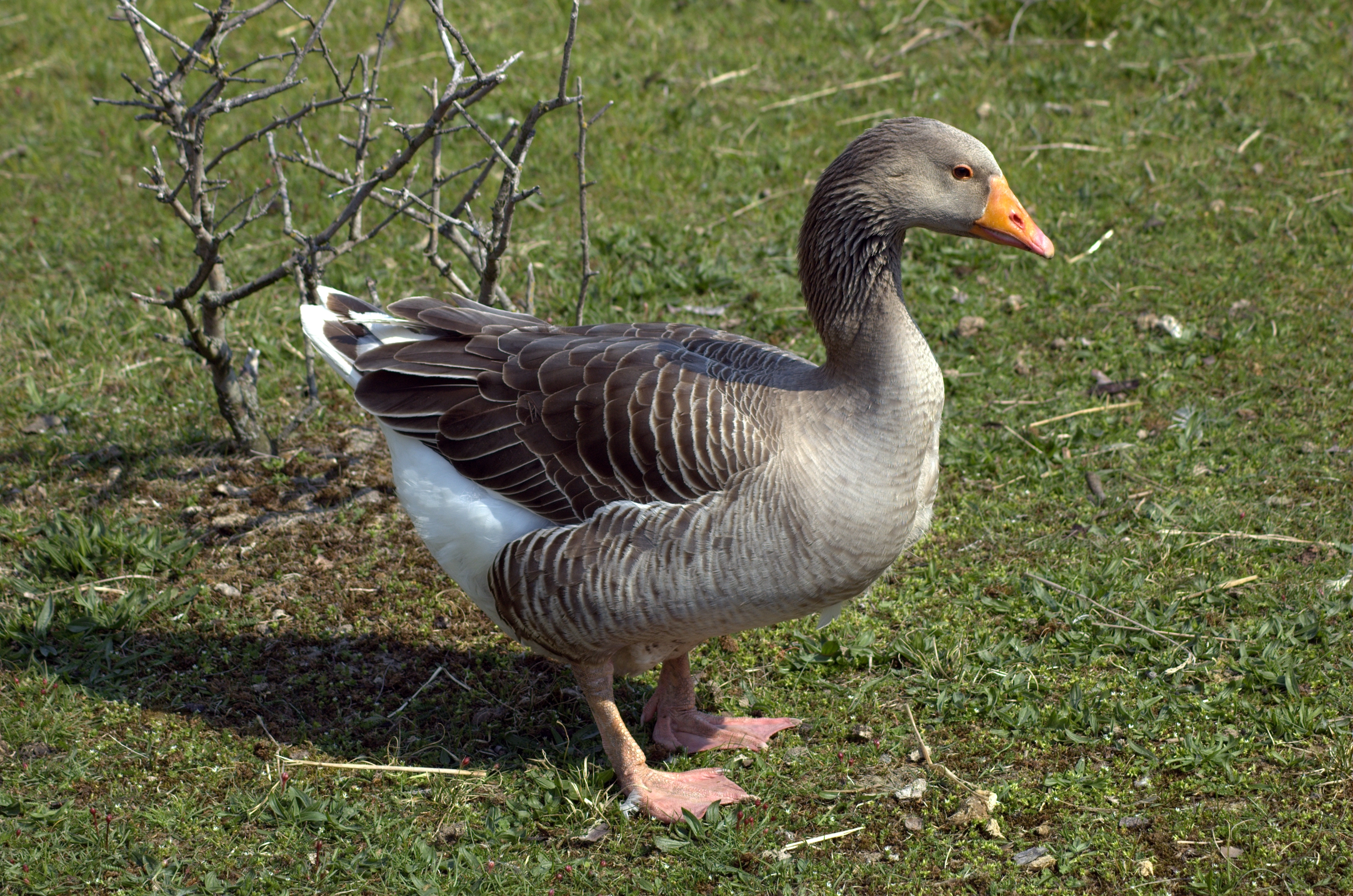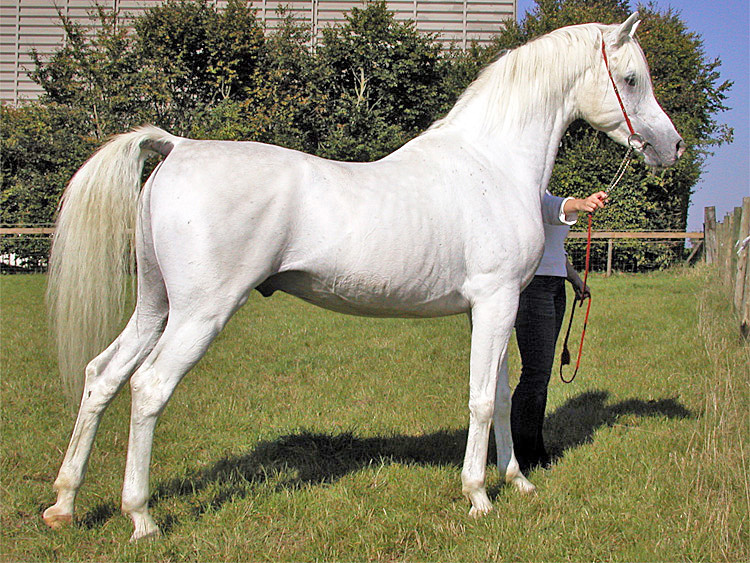|
Pilgrim Goose
Pilgrim geese (Australian Settler geese in AustraliaAustralian Poultry Standards, 2nd Edition, Published 2013 Victorian Poultry Breeders Association Ltd trading as Poultry Poultry Stud Breeders and Exhibitions Victoria) is a breed of domestic goose. They are considered to be a relatively quiet, lightweight and medium-sized breed. The pilgrim goose is a rare and critically endangered species according to the American Livestock Breeds Conservancy (ALBC) and was officially entered into the American Poultry Association's Standard of Perfection in 1939. Generally, they can live for 15 to 25 years. In most breeds of geese, males and females are indistinguishable from one another; however, the pilgrim goose is well-known for its auto-sexing trait. Males are characterised by white feathers while the females have grey. This sexual dimorphism makes pilgrim geese desirable for breeding as the sexes are easily determined. Their commercial use is primarily limited to the United States where th ... [...More Info...] [...Related Items...] OR: [Wikipedia] [Google] [Baidu] |
American Livestock Breeds Conservancy
The Livestock Conservancy, formerly known as the American Livestock Breeds Conservancy (ALBC) and prior to that, the American Minor Breeds Conservancy, is a nonprofit organization focused on preserving and promoting rare breeds, also known as "heritage breeds" of livestock. Founded in 1977, through the efforts of livestock breed enthusiasts concerned about the disappearance of many of the US's heritage livestock breeds, the Conservancy was the pioneer livestock preservation organization in the United States, and remains a leading organization in that field. It has initiated programs that have saved multiple breeds from extinction, and works closely with similar organizations in other countries, including Rare Breeds Canada. With 3,000 members, a staff of nine and a 19-member board of directors, the organization has an operating budget of almost half a million dollars. The Livestock Conservancy maintains a conservation priority list that divides endangered breeds of horses, asses ... [...More Info...] [...Related Items...] OR: [Wikipedia] [Google] [Baidu] |
Conservation Priority Breeds Of The Livestock Conservancy
Conservation is the preservation or efficient use of resources, or the conservation of various quantities under physical laws. Conservation may also refer to: Environment and natural resources * Nature conservation, the protection and management of the environment and natural resources * Conservation biology, the science of protection and management of biodiversity * Conservation movement, political, environmental, or social movement that seeks to protect natural resources, including biodiversity and habitat * Conservation organization, an organization dedicated to protection and management of the environment or natural resources * Wildlife conservation, the practice of protecting wild species and their habitats in order to prevent species from going extinct * ''Conservation'' (magazine), published by the Society for Conservation Biology from 2000 to 2014 ** ''Conservation Biology'' (journal), scientific journal of the Society for Conservation Biology Physical laws * Conser ... [...More Info...] [...Related Items...] OR: [Wikipedia] [Google] [Baidu] |
List Of Goose Breeds
__NOTOC__ This list contains breeds and landraces of domestic geese as well as species with semi-domestic populations. Geese are bred mainly for their meat, which is particularly popular in Germanic languages countries around Christmas. Of lesser commercial importance is goose breeding for eggs, schmaltz, or for the fattened liver ('' foie gras''). A few specialized breeds have been created for the main purpose of weed control (e.g. the Cotton Patch Goose), or as guard animals and (in former times) for goose fights (e.g., the Steinbach Fighting Goose and Tula Fighting Goose). Goose breeds are usually grouped into three weight classes: Heavy, Medium and Light. Most domestic geese are descended from the greylag goose (''Anser anser''). The Chinese and African Geese are the domestic breeds of the swan goose (''A. cygnoides''); they can be recognized by their prominent bill knob.APA (2001) Some breeds, like the Obroshin Goose and Steinbach Fighting Goose, originated in ... [...More Info...] [...Related Items...] OR: [Wikipedia] [Google] [Baidu] |
Chicken
The chicken (''Gallus gallus domesticus'') is a domesticated junglefowl species, with attributes of wild species such as the grey and the Ceylon junglefowl that are originally from Southeastern Asia. Rooster or cock is a term for an adult male bird, and a younger male may be called a cockerel. A male that has been castrated is a capon. An adult female bird is called a hen and a sexually immature female is called a pullet. Humans now keep chickens primarily as a source of food (consuming both their meat and eggs) and as pets. Traditionally they were also bred for cockfighting, which is still practiced in some places. Chickens are one of the most common and widespread domestic animals, with a total population of 23.7 billion , up from more than 19 billion in 2011. There are more chickens in the world than any other bird. There are numerous cultural references to chickens – in myth, folklore and religion, and in language and literature. Genetic studies have poi ... [...More Info...] [...Related Items...] OR: [Wikipedia] [Google] [Baidu] |
Crossbreed
A crossbreed is an organism with purebred parents of two different breeds, varieties, or populations. ''Crossbreeding'', sometimes called "designer crossbreeding", is the process of breeding such an organism, While crossbreeding is used to maintain health and viability of organisms, irresponsible crossbreeding can also produce organisms of inferior quality or dilute a purebred gene pool to the point of extinction of a given breed of organism. A domestic animal of unknown ancestry, where the breed status of only one parent or grandparent is known, may also be called a crossbreed though the term "mixed breed" is technically more accurate. Outcrossing is a type of crossbreeding used within a purebred breed to increase the genetic diversity within the breed, particularly when there is a need to avoid inbreeding. In animal breeding, ''crossbreeds'' are crosses within a single species, while '' hybrids'' are crosses between different species. In plant breeding terminology, the ... [...More Info...] [...Related Items...] OR: [Wikipedia] [Google] [Baidu] |
Purebred
Purebreds are " cultivated varieties" of an animal species achieved through the process of selective breeding. When the lineage of a purebred animal is recorded, that animal is said to be "pedigreed". Purebreds breed true-to-type which means the progeny of like-to-like purebred parents will carry the same phenotype, or observable characteristics of the parents. A group of purebreds is called a pure-breeding line or strain. True breeding In the world of selective animal breeding, to "breed true" means that specimens of an animal breed will breed true-to-type when mated like-to-like; that is, that the progeny of any two individuals of the same breed will show fairly consistent, replicable and predictable characteristics, or traits with sufficiently high heritability. A puppy from two purebred dogs of the same breed, for example, will exhibit the traits of its parents, and not the traits of all breeds in the subject breed's ancestry. However, breeding from too small a gene poo ... [...More Info...] [...Related Items...] OR: [Wikipedia] [Google] [Baidu] |
Fertility
Fertility is the capability to produce offspring through reproduction following the onset of sexual maturity. The fertility rate is the average number of children born by a female during her lifetime and is quantified demographically. Fertility is addressed when there is a difficulty or an inability to reproduce naturally, which is referred to as infertility. Infertility is widespread, with fertility specialists available all over the world to assist mothers and couples who experience difficulties having a baby. Human fertility depends on factors of nutrition, sexual behaviour, consanguinity, culture, instinct, endocrinology, timing, economics, personality, way of life, and emotions. Fertility differs from fecundity, which is defined as the ''potential'' for reproduction (influenced by gamete production, fertilization and carrying a pregnancy to term). Where a woman or the lack of fertility is infertility while a lack of fecundity would be called sterility. Demograp ... [...More Info...] [...Related Items...] OR: [Wikipedia] [Google] [Baidu] |
Breeding Season
Seasonal breeders are animal species that successfully mate only during certain times of the year. These times of year allow for the optimization of survival of young due to factors such as ambient temperature, food and water availability, and changes in the predation behaviors of other species. Related sexual interest and behaviors are expressed and accepted only during this period. Female seasonal breeders will have one or more estrus cycles only when she is "in season" or fertile and receptive to mating. At other times of the year, they will be anestrus, or have a dearth of their sexual cycle. Unlike reproductive cyclicity, seasonality is described in both males and females. Male seasonal breeders may exhibit changes in testosterone levels, testes weight, and fertility depending on the time of year. Seasonal breeders are distinct from opportunistic breeders, that mate whenever the conditions of their environment become favorable, and continuous breeders that mate year-ro ... [...More Info...] [...Related Items...] OR: [Wikipedia] [Google] [Baidu] |
Domestic Goose
A domestic goose is a goose that humans have domesticated and kept for their meat, eggs, or down feathers. Domestic geese have been derived through selective breeding from the wild greylag goose (''Anser anser domesticus'') and swan goose (''Anser cygnoides domesticus''). Origins In Europe, northern Africa, and western Asia, the original domesticated geese are derived from the greylag goose (''Anser anser''). In eastern Asia, the original domesticated geese are derived from the swan goose (''Anser cygnoides''); these are commonly known as Chinese geese. Both have been widely introduced in more recent times, and modern flocks in both areas (and elsewhere, such as Australia and North America) may consist of either species or hybrids between them. Chinese geese may be readily distinguished from European geese by the large knob at the base of the bill, though hybrids may exhibit every degree of variation between the two species. Charles Darwin remarked in ''The Variation of Anim ... [...More Info...] [...Related Items...] OR: [Wikipedia] [Google] [Baidu] |
Seasonal Breeder
Seasonal breeders are animal species that successfully mate only during certain times of the year. These times of year allow for the optimization of survival of young due to factors such as ambient temperature, food and water availability, and changes in the predation behaviors of other species. Related sexual interest and behaviors are expressed and accepted only during this period. Female seasonal breeders will have one or more estrus cycles only when she is "in season" or fertile and receptive to mating. At other times of the year, they will be anestrus, or have a dearth of their sexual cycle. Unlike reproductive cyclicity, seasonality is described in both males and females. Male seasonal breeders may exhibit changes in testosterone levels, testes weight, and fertility depending on the time of year. Seasonal breeders are distinct from opportunistic breeders, that mate whenever the conditions of their environment become favorable, and continuous breeders that mate year-rou ... [...More Info...] [...Related Items...] OR: [Wikipedia] [Google] [Baidu] |
Pomeranian Goose
The Pomeranian goose (german: link=no, Pommerngans,''Der Große Geflügelstandard in Farbe'', Bd. 3. Wassergeflügel: Gänse und Enten. Oertel + Spörer. French: ''L'oie de Poméranie'' Pomeranian, Toulouse or Emden goose eggs), also known as the Rügener goose, is a breed of domestic goose. Although only an officially recognized breed since 1912, this fowl was developed by Northern German farmers of Pomerania as early as 1500. Ashton, Chris. 1999. ''Domestic Geese''. The Crowned Press, LTD. Ramsbury, England. While it is popular as a market goose throughout Europe FeatherSite: Pomeranian Geese – especially in (Germany), |





